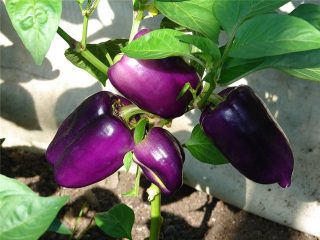A huge number of different sweet bell pepper seeds allows each farmer to choose the best variety that matches his taste and aesthetic preferences. At the same time, there are a series of varieties with similar agrotechnical characteristics and taste qualities of the fruits, but with different colors. For example, the so-called bulls are represented by peppers red and yellow. Among other yellow-fruited varieties, the “Yellow Bull” pepper is distinguished by its particularly large, sweet fruit, high yield and other advantages, which will be discussed in this article.
Taste and external qualities of pepper
"Yellow Bull" is a hybrid. It was obtained by domestic breeders by crossing two varieties of pepper. The “calling card” of the variety is considered to be a huge fruit: the length of the vegetable reaches 20 cm, in cross section the diameter is 8 cm. The pulp of the “Yellow Bull” is very thick - 10 mm. The average weight of a vegetable varies from 200 to 250 g. Particularly large fruits can weigh up to 400 g. Their skin is thin, tender, and the surface is glossy. The vegetable has the shape of a truncated cone, with three to four clearly defined edges and a depressed stalk. During the growth period, the fruits are colored green, and upon reaching technical ripeness their color becomes golden yellow.
The taste of the vegetable is excellent: the thick flesh is exceptionally tender, juicy, and sweet.The amazing fresh aroma of pepper will surely be remembered by everyone who has tried it at least once. The purpose of the fruit is universal. It is consumed fresh, canned, and used to create culinary masterpieces.
Agricultural technology
The hybrid “Yellow Bull” is thermophilic, therefore it is zoned for southern and central Russia. However, based on the experience of farmers, it can be argued that the variety bears fruit excellently even in more severe climatic conditions in the presence of a greenhouse. When growing crops in open areas, it is necessary to ensure maximum illumination and protection of plants from the wind.
The period from sowing the seeds of the “Yellow Bull” variety to abundant fruiting is 110-125 days. Considering this duration of ripening, you can calculate the best time for sowing seedlings. In the middle climate zone it occurs in March. Seedlings at the age of 2 months will need to be planted in the ground. Mass harvesting with this cultivation schedule can be carried out in July. You can taste the first fruits 1-2 weeks earlier.
The “Yellow Bull” pepper variety can be grown in open areas and under film cover, in greenhouses, and greenhouses. The soil favorable for cultivation is sandy-clayey, nutritious, with a high content of organic matter.
The variety is represented by vigorous bushes up to 1.5 m high. The recommended scheme for their cultivation involves placing no more than 4 bushes per 1 m2 soil. Plants of the “Yellow Bull” variety need to be tied up. It is best to use a trellis for this.During the growth process, it is necessary to form a pepper bush, removing the lower and overly growing shoots.
Mandatory plant care includes regular watering, loosening, and weeding. It is recommended to fertilize peppers during the growing process every 3 weeks, adding fertilizer containing nitrogen, phosphorus and potassium. There is no need to treat Yellow Bull pepper bushes with chemicals that resist various diseases, since the crop is genetically protected from most specific ailments. You can learn more about the features of crop care in open and protected ground conditions from the video:
The yellow-fruited variety produces ovaries abundantly until the onset of cold weather, which makes it possible to achieve high yields. Thus, when growing peppers in open areas, the yield of the variety is approximately 7-9 kg/m2however, in greenhouse conditions or when using a heated greenhouse, this figure can increase to 20 kg/m2.
“Yellow Bull” is one of the most popular varieties among professional farmers, as it allows one to obtain a record yield of fruits of high taste and external quality for the crop. At the same time, long-term storage and transportation of peppers does not affect their presentation. The variety is also loved among beginning gardeners because it does not require compliance with complex cultivation rules and allows you to easily obtain a rich harvest of tasty, beautiful peppers.











